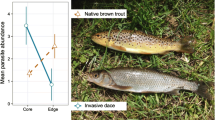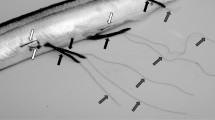Abstract
Ecologically sustainable disease prevention in intensive monocultures, such as fish farming, is based on the knowledge of the ecology of parasites and the identification of the key proportion of host populations for parasite life cycles. In this paper, we examined the life cycle dynamics of the pathogenic trematode Diplostomum spathaceum at a fish farm during a period of 1 year, focusing especially on the pattern of infection in the snail host (Lymnaea stagnalis) population, which is the key phase in the parasite life cycle regarding preventative actions. We found that (1) the infection varied seasonally in snails, being highest in late August; (2) the prevalence of infection and the proportion of individuals releasing cercariae were strongly dependent on snail size; (3) the parasite over-wintered in snails as dormant sporocysts and 4) the mortality of infected snails was not likely to differ from uninfected individuals during winter. Furthermore, the seasonality and development of the infection in the snails corresponded to the pattern of infection observed in the tracer rainbow trout caged in the farm area. This pattern of infection also indicated strong spatiality of the infection, probably because of differences in the size of the snail population between the ponds rather than differences in the prevalence of infection. Overall, present results indicate a possibility for late-summer outbreaks of D. spathaceum, but also that snail prevention at farms could be conducted more efficiently by considering both size-dependent infection and the timing of cercarial release.



Similar content being viewed by others
References
Bauer ON (1961) Parasitic diseases of cultured fishes and methods of their prevention and treatment. In: Dogiel VA, Petrushevski GK, Polyanski YI (eds) Parasitology of fishes. Oliver & Boyd, Edinburgh, pp 265–298
Briers RA (2003) Range limits and parasite prevalence in a freshwater snail. Proc R Soc Lond B 270:S178–S180
Brown KM, Leathers BK, Minchella DJ (1988) Trematode prevalence and the population dynamics of freshwater pond snails. Am Midl Nat 120:289–301
Buchmann K, Uldal A (1994) Effects of eyefluke infections on the growth of rainbow trout (Oncorhynchus mykiss) in a mariculture system. Bull Eur Assoc Fish Pathol 14:104–107
Buchmann K, Møller SH, Uldal A, Bresciani J (1997) Different seasonal infection dynamics of two species of eye-flukes (Diplostomum spathaceum and Tylodelphys clavata) in rainbow trout (Oncorhynchus mykiss). Bull Eur Assoc Fish Pathol 17:165–170
Chappell LH, Hardie LJ, Secombes CJ (1994) Diplostomiasis: the disease and host-parasite interactions. In: Pike AW, Lewis JW (eds) Parasitic diseases of fish. Samara, Dyfed, pp 59–86
Crowden AE, Broom DM (1980) Effects of the eyefluke, Diplostomum spathaceum, on the behaviour of dace (Leuciscus leuciscus). Anim Behav 28:287–294
Field JS, Irwin SWB (1994) The epidemiology, treatment and control of diplostomiasis on a fish farm in Northern Ireland. In: Pike AW, Lewis JW (eds) Parasitic diseases of fish. Samara, Dyfed, pp 87–100
Goater TM, Shostak AW, Williams JA, Esch GW (1989) A mark-recapture study of trematode parasitism in overwintered Helisoma anceps (Pulmonata), with special reference to Halipegus occidualis (Hemiuridae). J Parasitol 75:553–560
Hakalahti T, Valtonen ET (2003) Population structure and recruitment of the ectoparasite Argulus coregoni Thorell (Crustacea: Branchiura) on a fish farm. Parasitology 127:79–85
Hudson PJ, Rizzoli A, Grenfell BT, Heesterbeek H, Dobson AP (2002) The ecology of wildlife diseases. Oxford University Press, Oxford
Jokela J, Lively CM (1995) Spatial variation in infection by digenetic trematodes in a population of freshwater snails (Potamopyrgus antipodarum). Oecologia 103:509–517
Jokela J, Lively CM, Taskinen J, Peters AD (1999) Effect of starvation on parasite-induced mortality in a freshwater snail (Potamopyrgus antipodarum). Oecologia 119:320–325
Jokela J, Taskinen J, Mutikainen P, Kopp K (2005) Virulence of parasites in hosts under environmental stress: experiments with anoxia and starvation. Oikos 108:156–164
Karvonen A, Kirsi S, Hudson PJ, Valtonen ET (2004a) Patterns of cercarial production from Diplostomum spathaceum: terminal investment or bet hedging? Parasitology 129:87–92
Karvonen A, Seppälä O, Valtonen ET (2004b) Eye fluke-induced cataract formation in fish: quantitative analysis using an ophthalmological microscope. Parasitology 129:473–478
Karvonen A, Seppälä O, Valtonen ET (2004c) Parasite resistance and avoidance behaviour in preventing eye fluke infections in fish. Parasitology 129:159–164
Karvonen A, Paukku S, Seppälä O, Valtonen ET (2005) Resistance against eye flukes: naïve versus previously infected fish. Parasitol Res 95:55–59
Krist AC, Jokela J, Wiehn J, Lively CM (2004) Effects of host condition on susceptibility to infection, parasite developmental rate, and parasite transmission in a snail–trematode interaction. J Evol Biol 17:33–40
Lauckner G (1986) Ecological effects of larval trematode infestation on littoral marine invertebrate populations. In: Howell MJ (ed) Parasitology—quo vadit? Proceedings of the 6th international congress of parasitology, Brisbane, pp 391–397
Loy C, Haas W (2001) Prevalence of cercariae from Lymnaea stagnalis snails in a pond system in southern Germany. Parasitol Res 87:878–882
McKeown CA, Irwin SWB (1997) Accumulation of Diplostomum spp. (Digenea: Diplostomatidae) metacercariae in the eyes of 0+ and 1+ roach (Rutilus rutilus). Int J Parasitol 27:377–380
Mo TA (1994) Status of Gyrodactylus salaris problems and research in Norway. Pike AW, Lewis JW (eds) Parasitic diseases of fish. Samara, Dyfed, pp 43–56
Niewiadomska K (1986) Verification of the life-cycles of Diplostomum spathaceum (Rudolphi, 1819) and D. pseudospathaceum Niewiadomska, 1984 (Trematoda, Diplostomidae). Syst Parasitol 8:23–31
Owen SF, Barber I, Hart PJB (1993) Low level infection by eye fluke, Diplostomum spp., affects the vision of three-spined sticklebacks, Gasterosteus aculeatus. J Fish Biol 42:803–806
Rintamäki-Kinnunen P, Valtonen ET (1996) Gyrodactylus salaris at fish farms in northern Finland over a period of ten years. Int J Parasitol 26:723–732
Rintamäki-Kinnunen P, Valtonen ET (1997) Epizootiology of protozoans in farmed salmonids at northern latitudes. Int J Parasitol 27:89–99
Roth M, Richards RH, Sommerville C (1993) Current practises in the chemotherapeutic control of sea lice infestations in aquaculture: a review. J Fish Dis 16:1–26
Sangster CR, Dove ADM, Bowser PR (2004) Diplostomum in pond-reared walleye Stizostedion vitreum—implications of a management strategy for control. Aquaculture 236:95–102
Seppälä O, Karvonen A, Valtonen ET (2004) Parasite-induced change in host behaviour and susceptibility to predation in an eye fluke–fish interaction. Anim Behav 68:257–263
Shariff M, Richards RH, Sommerville C (1980) The histopathology of acute and chronic infections of rainbow trout Salmo gairdneri Richardson with eye flukes, Diplostomum spp. J Fish Dis 3:455–465
Stables JN, Chappell LH (1986) The epidemiology of diplostomiasis in farmed rainbow trout from north-east Scotland. Parasitology 92:699–710
Sweeting RA (1974) Investigations into natural and experimental infections of freshwater fish by the common eye-fluke Diplostomum spathaceum Rud. Parasitology 69:291–300
Valtonen ET, Gibson DI (1997) Aspects of the biology of diplostomid metacercarial (Digenea) populations occurring in fishes in different localities in northern Finland. Ann Zool Fenn 34:47–59
Valtonen ET, Holmes JC, Koskivaara M (1997) Eutrophication, pollution and fragmentation: effects on parasite communities of roach (Rutilus rutilus) and perch (Perca fluviatilis) in four lakes in central Finland. Can J Fish Aquat Sci 54:572–585
Valtonen ET, Holmes JC, Aronen J, Rautalahti I (2003) Parasite communities as indicators of recovery from pollution: parasites of roach (Rutilus rutilus) and perch (Perca fluviatilis) in Central Finland. Parasitology 126:S43–S52
Acknowledgements
We thank Yrjö Lankinen for the fish material and facilities, and the farm staff for assistance. The study was supported by the Finnish Cultural Foundation, Kone Foundation and the Sustainable Use of Natural Resources research programme of the Academy of Finland. The experiments conducted in this study were approved by the lab-animal care and use committee of the University of Jyväskylä and comply with the laws of Finland.
Author information
Authors and Affiliations
Corresponding author
Rights and permissions
About this article
Cite this article
Karvonen, A., Savolainen, M., Seppälä, O. et al. Dynamics of Diplostomum spathaceum infection in snail hosts at a fish farm. Parasitol Res 99, 341–345 (2006). https://doi.org/10.1007/s00436-006-0137-8
Received:
Accepted:
Published:
Issue Date:
DOI: https://doi.org/10.1007/s00436-006-0137-8




